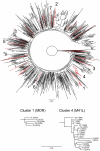Low prevalence of transmitted drug resistance in patients newly diagnosed with HIV-1 infection in Sweden 2003-2010
- PMID: 22448246
- PMCID: PMC3308981
- DOI: 10.1371/journal.pone.0033484
Low prevalence of transmitted drug resistance in patients newly diagnosed with HIV-1 infection in Sweden 2003-2010
Abstract
Transmitted drug resistance (TDR) is a clinical and epidemiological problem because it may contribute to failure of antiretroviral treatment. The prevalence of TDR varies geographically, and its prevalence in Sweden during the last decade has not been reported. Plasma samples from 1,463 patients newly diagnosed with HIV-1 infection between 2003 and 2010, representing 44% of all patients diagnosed in Sweden during this period, were analyzed using the WHO 2009 list of mutations for surveillance of TDR. Maximum likelihood phylogenetic analyses were used to determine genetic subtype and to investigate the relatedness of the sequences. Eighty-two patients showed evidence of TDR, representing a prevalence of 5.6% (95% CI: 4.5%-6.9%) without any significant time trends or differences between patients infected in Sweden or abroad. Multivariable logistic regression showed that TDR was positively associated with men who have sex with men (MSM) and subtype B infection and negatively associated with CD4 cell counts. Among patients with TDR, 54 (68%) had single resistance mutations, whereas five patients had multi-drug resistant HIV-1. Phylogenetic analyses identified nine significantly supported clusters involving 29 of the patients with TDR, including 23 of 42 (55%) of the patients with TDR acquired in Sweden. One cluster contained 18 viruses with a M41L resistance mutation, which had spread among MSM in Stockholm over a period of at least 16 years (1994-2010). Another cluster, which contained the five multidrug resistant viruses, also involved MSM from Stockholm. The prevalence of TDR in Sweden 2003-2010 was lower than in many other European countries. TDR was concentrated among MSM, where clustering of TDR strains was observed, which highlights the need for continued and improved measures for targeted interventions.
Conflict of interest statement
Figures

Similar articles
-
Increase in transmitted drug resistance in migrants from sub-Saharan Africa diagnosed with HIV-1 in Sweden.AIDS. 2018 Apr 24;32(7):877-884. doi: 10.1097/QAD.0000000000001763. AIDS. 2018. PMID: 29369826
-
Low prevalence of transmitted drug resistance among newly diagnosed HIV-1 patients in Latvia.J Med Virol. 2010 Dec;82(12):2013-8. doi: 10.1002/jmv.21921. J Med Virol. 2010. PMID: 20981787
-
Surveillance of HIV-1 pol transmitted drug resistance in acutely and recently infected antiretroviral drug-naïve persons in rural western Kenya.PLoS One. 2017 Feb 8;12(2):e0171124. doi: 10.1371/journal.pone.0171124. eCollection 2017. PLoS One. 2017. PMID: 28178281 Free PMC article.
-
Prevalence and determinants of transmitted antiretroviral drug resistance in HIV-1 infection.J Antimicrob Chemother. 2007 Jun;59(6):1047-56. doi: 10.1093/jac/dkm082. Epub 2007 Apr 19. J Antimicrob Chemother. 2007. PMID: 17449483 Review.
-
Primary drug resistance in South Africa: data from 10 years of surveys.AIDS Res Hum Retroviruses. 2012 Jun;28(6):558-65. doi: 10.1089/aid.2011.0284. Epub 2012 Mar 12. AIDS Res Hum Retroviruses. 2012. PMID: 22251009 Free PMC article. Review.
Cited by
-
Defining HIV-1 transmission clusters based on sequence data.AIDS. 2017 Jun 1;31(9):1211-1222. doi: 10.1097/QAD.0000000000001470. AIDS. 2017. PMID: 28353537 Free PMC article.
-
Clinically relevant transmitted drug resistance to first line antiretroviral drugs and implications for recommendations.PLoS One. 2014 Mar 17;9(3):e90710. doi: 10.1371/journal.pone.0090710. eCollection 2014. PLoS One. 2014. PMID: 24637804 Free PMC article.
-
Challenges with using primer IDs to improve accuracy of next generation sequencing.PLoS One. 2015 Mar 5;10(3):e0119123. doi: 10.1371/journal.pone.0119123. eCollection 2015. PLoS One. 2015. PMID: 25741706 Free PMC article.
-
Evaluation of sequence ambiguities of the HIV-1 pol gene as a method to identify recent HIV-1 infection in transmitted drug resistance surveys.Infect Genet Evol. 2013 Aug;18:125-31. doi: 10.1016/j.meegid.2013.03.050. Epub 2013 Apr 11. Infect Genet Evol. 2013. PMID: 23583545 Free PMC article.
-
Advances in research of HIV transmission networks.Chin Med J (Engl). 2020 Dec 5;133(23):2850-2858. doi: 10.1097/CM9.0000000000001155. Chin Med J (Engl). 2020. PMID: 33273335 Free PMC article.
References
-
- Wittkop L, Gunthard HF, de Wolf F, Dunn D, Cozzi-Lepri A, et al. Effect of transmitted drug resistance on virological and immunological response to initial combination antiretroviral therapy for HIV (EuroCoord-CHAIN joint project): a European multicohort study. Lancet Infect Dis. 2011;11:363–371. - PubMed
-
- Bennett DE, Bertagnolio S, Sutherland D, Gilks CF. The World Health Organization's global strategy for prevention and assessment of HIV drug resistance. Antivir Ther. 2008;13(Suppl 2):1–13. - PubMed
-
- Bennett DE, Myatt M, Bertagnolio S, Sutherland D, Gilks CF. Recommendations for surveillance of transmitted HIV drug resistance in countries scaling up antiretroviral treatment. Antivir Ther. 2008;13(Suppl 2):25–36. - PubMed
-
- Josephson F, Albert J, Flamholc L, Gisslen M, Karlström O, et al. Treatment of HIV infection: Swedish recommendations 2009. Scand J Infect Dis. 2009;41:788–807. - PubMed
-
- Hirsch MS, Gunthard HF, Schapiro JM, Brun-Vezinet F, Clotet B, et al. Antiretroviral drug resistance testing in adult HIV-1 infection: 2008 recommendations of an International AIDS Society-USA panel. Clin Infect Dis. 2008;47:266–285. - PubMed
Publication types
MeSH terms
Substances
LinkOut - more resources
Full Text Sources
Medical
Molecular Biology Databases
Research Materials

